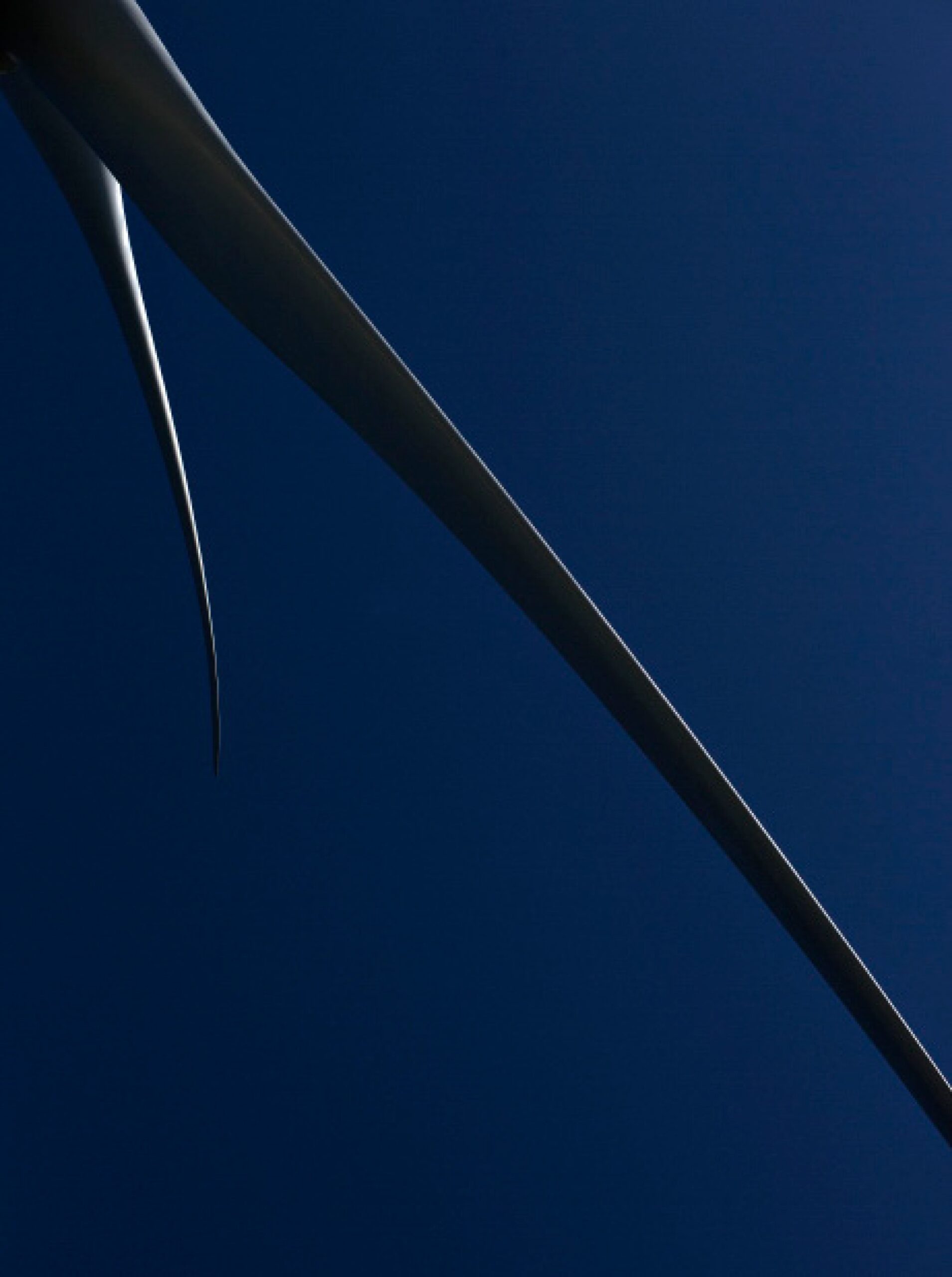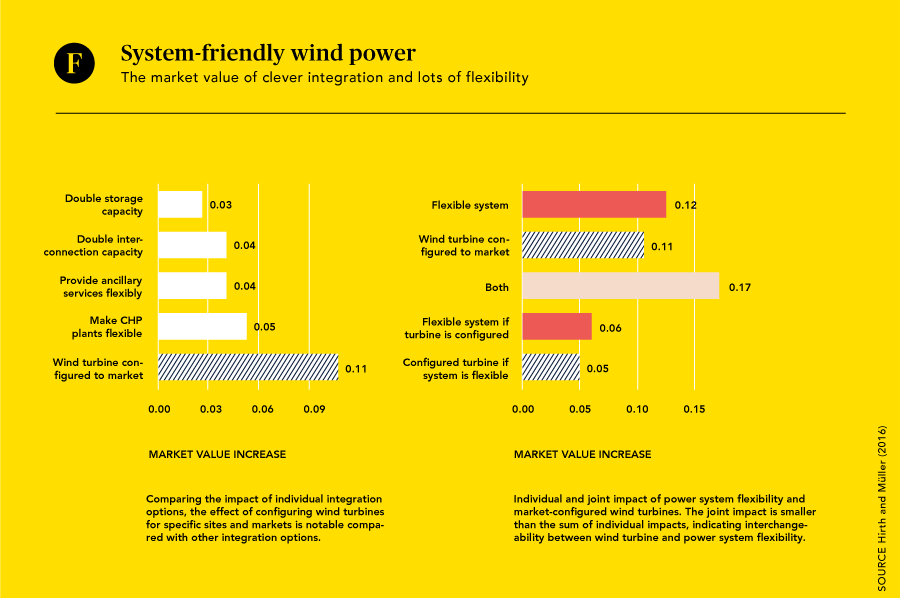DRIVING DOWN THE COST OF WIND
By pricing the value of wind energy according to when and where it is produced, markets stimulate the development and sale of wind turbines that are configured to generate steady volumes of energy over longer periods of time, reducing their variability of supply.
As electricity markets have evolved to integrate ever more wind power, the technology has also evolved in response to changing economic realities. Wind turbines today can be delivered in a variety of combinations of generator size and rotor diameter, providing the option to configure them for specific sites and markets and to deliver energy that has most value to the power system.
The irony of wind generation is that on power systems with high shares of wind energy in the mix, the windier the weather, the lower the market value of the electricity produced. Swamp demand for a product with too much of it and market prices will fall. Electricity is no exception.
Back in the days when wind turbines were still classed in the “promising” category, designers focused on creating machines that would prove their value by generating lots of electricity. The bigger the generator incorporated into a wind turbine, the more electricity it produces when the resource is at its best — in a good blow. Windy days often mean colder weather and more demand for electricity, pushing up its value. Particularly in northern Europe, the timing of wind supply and consumer demand seemed like a match made in heaven.
The market logic gets turned on its head, however, when sufficient numbers of wind turbines are installed to swamp the available capacity of the transmission network to take the electricity on windy days from where it is being generated to the centres of load where it is needed. Follow that thought into a future when all electricity comes from renewable sources, and installing turbines and grid technology dimensioned, at extra cost, for high volumes of generation delivered for short periods when electricity supply may be abundant, potentially defies economic sense.
BIRTH OF THE LOW-WIND TURBINE
The challenge of “too much of a good thing” on the horizon is giving encouragement to the further development of wind turbines that operate closer to their rated capacity for longer periods in relatively lower winds. Instead of capturing maximum energy from the maximum wind resource, a wind turbine that increases the average power delivered over a longer period can make better use of times when market prices for electricity may be higher, at least in areas with large volumes of wind capacity.
Such machines began to be aggressively marketed a decade or so ago, but for a different reason. The best wind sites were taken and project developers wanted turbines that would operate profitably in weaker wind areas. A new breed of “low-wind” wind turbine was born with low specific power capacity. Relative to its rotor size, the low-wind turbine has a smaller generator than one designed for maximum energy capture in high winds and as a result operates at a higher capacity factor.It opens up regions of the world earlier dismissed as not having sufficient winds to make wind power economically viable. The low-wind turbine may also make sense if market prices persist in rising as the wind drops and supply falls.
UNDERSTANDING CAPACITY FACTOR
Capacity factor, also known as load factor, denotes the share of production relative to what the turbine could have produced if it operated at full load all the time. No power plant operates continually at full capacity. All suffer planned or unplanned downtime for repairs and maintenance. Wind and solar are no exception and their capacity factors are also influenced by the availability of the energy resource.
A wind turbine with a low capacity factor is likely to be located in a region where the winds are seldom strong enough for it to operate frequently at the full rated capacity of its generator over long periods. By reducing the relative size of the generator, or increasing the size of the rotor, the rated capacity can be increased. Downsizing the generator relative to rotor diameter would sacrifice maximum generation at high winds, but the reduced cost of the equipment may mean a lower cost of energy over its life span. Getting the balance right is the trick.
Taken to its extreme, if a large modern turbine with a rotor diameter in excess of 120 metres was equipped with a small generator with a capacity of just a few kilowatt it would produce power at full capacity nearly all the time, even in a sheltered valley; its capacity factor could be in excess of 95%. The machine’s extremely low productivity, however, would rule out any chance of commercial viability. It would generate insufficient revenues to ever pay for its cost.
Achieving the correct balance between rotor diameter and generator size may depend on the market in which the wind turbine will operate. A market with plenty of wind that pays a good price for all the energy generated could tend to favour the installation of wind turbines with relatively big generators that reap maximum energy from high winds. Conversely, a market of moderate winds and variable prices driven by the forces of demand and supply could favour a wind turbine with a relatively large rotor for its generator capacity that produces electricity closer to its full rated capacity for longer periods, potentially when electricity is needed most and thus has most value.
THE RIGHT INCENTIVES
The trend in sale of wind turbines with larger rotors relative to rated capacity has spread to most markets. Germany, swept as it is by moderate winds and only short periods of high winds, was an earlier adopter of the change. It could remain a trend setter.
Corrections to market regulations by the German government now encourage sales of wind energy directly into wholesale markets, a job generally undertaken by electricity traders acting as professional middlemen. With their skills in squeezing most profit
out of markets, traders are adept at identifying the times of day when prices are highest and how best to exploit them on behalf of the owners of the wind generation they are charged with selling.
The more wind energy that can be sold when winds are moderate and market prices rise in response to falling supply, the better the return. Faced with this reality, owners have not needed much persuasion to abandon their long time reliance on kilowatt hour payments at a fixed rate under the country’s so-called “feed-in tariff” for wind energy and move to what became known as the “market direct” model. Increasingly, new owners have reason to buy turbines configured specifically for a site.
“In the past, operating under feed-in tariff schemes, such as those employed in the EU, China and elsewhere, wind farm owners and operators didn’t care when or where they were producing — they were paid an amount proportional to the amount of energy they produced,” says grid integration specialist Simon Müller, who together with colleague Lion Hirth at the Hertie School of Governance in Berlin is pushing the case for what they call “system friendly wind power.” Paying a fixed price for electricity can catalyse a market for wind power where there is none, but there is a downside.
“[It] creates an incentive to design and manufacture turbines that tend to overlook the overall impact on the system,” says Müller, who heads the Systems Integration of Renewables unit for the International Energy Agency. “So basically we were designing machines that convert wind to electricity that may not be worth a lot.”
The new challenge is to design markets which are not only highly sensitive to recognising the market value of electricity at different times in different places, but send out the right signals to stimulate investment in developing and installing wind turbines with the best relative configuration of rotor and generator size for any given location. Time of use pricing and locational marginal pricing are two possibilities.
“A lot of the work we’re doing involves coming up with ways to change incentive systems so that wind industry participants recognise and value the incentives to manufacture and install these types of higher value designs,” says Müller. “There’s great potential for improvement if we get those right,” he adds.
Wind turbines will always generate most in windy weather, creating a potential glut of electricity no matter how they are configured. The low-wind turbine is not a final solution, but in reducing the weight and size of the generator, gearbox and other components it lowers the cost of wind power. Moreover, shaving a wind turbine’s peak output while increasing its average power delivery provides for more efficient use of grid capacity, with a further cost benefit resulting. •
..TEXT Andrew Burger and Lyn Harrison PHOTO Lars Just


